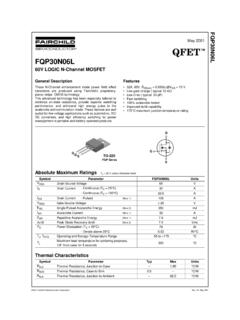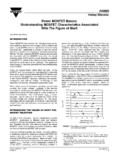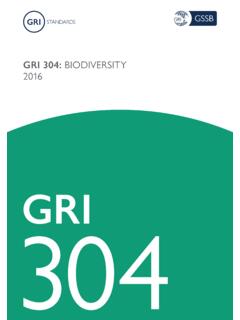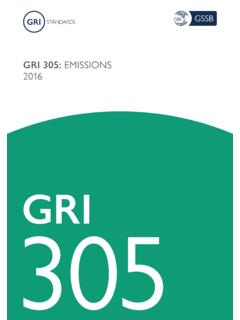Transcription of 2.3 Medical Waste Incineration
1 7/93 (Reformatted 1/95) Solid Waste Disposal Medical Waste Incineration Medical Waste Incineration involves the burning of wastes produced by hospitals, veterinary facilities, and Medical research facilities. These wastes include both infectious ("red bag") Medical wastes as well as non-infectious, general housekeeping wastes. The emission factors presented here represent emissions when both types of these wastes are combusted rather than just infectious wastes. Three main types of incinerators are used: controlled air, excess air, and rotary kiln. Of the incinerators identified in this study, the majority (>95 percent) are controlled air units.
2 A small percentage (<2 percent) are excess air. Less than 1 percent were identified as rotary kiln. The rotary kiln units tend to be larger, and typically are equipped with air pollution control devices. Approximately 2 percent of the total population identified in this study were found to be equipped with air pollution control devices. Process Description1-6 Types of Incineration described in this section include: - Controlled air, - Excess air, and - Rotary kiln. Controlled-Air Incinerators - Controlled-air Incineration is the most widely used Medical Waste incinerator (MWI) technology, and now dominates the market for new systems at hospitals and similar Medical facilities.
3 This technology is also known as starved-air Incineration , two-stage Incineration , or modular combustion. Figure presents a typical schematic diagram of a controlled air unit. Combustion of Waste in controlled air incinerators occurs in two stages. In the first stage, Waste is fed into the primary, or lower, combustion chamber, which is operated with less than the stoichiometric amount of air required for combustion. Combustion air enters the primary chamber from beneath the incinerator hearth (below the burning bed of Waste ). This air is called primary or underfire air. In the primary (starved-air) chamber, the low air-to-fuel ratio dries and facilitates volatilization of the Waste , and most of the residual carbon in the ash burns.
4 At these conditions, combustion gas temperatures are relatively low (760 to 980 C [1,400 to 1,800 F]). In the second stage, excess air is added to the volatile gases formed in the primary chamber to complete combustion. Secondary chamber temperatures are higher than primary chamber temperatures--typically 980 to 1,095 C (1,800 to 2,000 F). Depending on the heating value and moisture content of the Waste , additional heat may be needed. This can be provided by auxiliary burners located at the entrance to the secondary (upper) chamber to maintain desired temperatures. Waste feed capacities for controlled air incinerators range from about to 50 kg/min (75 to 6,500 lb/hr) (at an assumed fuel heating value of 19,700 kJ/kg [8,500 Btu/lb]).
5 Waste feed and ash removal can be manual or automatic, depending on the unit size and options purchased. Throughput capacities for lower heating value wastes may be higher, since feed capacities are limited by primary EMISSION FACTORS (Reformatted 1/95) 7/93 chamber heat release rates. Heat release rates for controlled air incinerators typically range from about 430,000 to 710,000 kJ/hr-m3 (15,000 to 25,000 Btu/hr-ft3). Waste Feed Controlled Underfire Air for Burning Down Waste Starved-Air Condition in Lower Chamber Air Air Volatile Content is Burned in Upper Chamber Carbon Dioxide Water Vapor and Excess Oxygen and Nitrogen to Atmosphere Main Burner for Minimum Combustion Temperature Excess Air Condition Upper Chamber Lower Chamber 7/93 (Reformatted 1/95) Solid Waste Disposal Figure Controlled Air Incinerator Because of the low air addition rates in the primary chamber, and corresponding low flue gas velocities (and turbulence), the amount of solids entrained in the gases leaving the primary chamber is low.
6 Therefore, the majority of controlled air incinerators do not have add-on gas cleaning devices. Excess Air Incinerators - Excess air incinerators are typically small modular units. They are also referred to as batch incinerators, multiple chamber incinerators, or "retort" incinerators. Excess air incinerators are typically a compact cube with a series of internal chambers and baffles. Although they can be operated continuously, they are usually operated in a batch mode. Figure presents a schematic for an excess air unit. Typically, Waste is manually fed into the combustion chamber. The charging door is then closed, and an afterburner is ignited to bring the secondary chamber to a target temperature (typically 870 to 980 C [1600 to 1800 F]).
7 When the target temperature is reached, the primary chamber burner ignites. The Waste is dried, ignited, and combusted by heat provided by the primary chamber burner, as well as by radiant heat from the chamber walls. Moisture and volatile components in the Waste are vaporized, and pass (along with combustion gases) out of the primary chamber and through a flame port which connects the primary chamber to the secondary or mixing chamber. Secondary air is added through the flame port and is mixed with the volatile components in the secondary chamber. Burners are also installed in the secondary chamber to maintain adequate temperatures for combustion of volatile gases.
8 Gases exiting the secondary chamber are directed to the incinerator stack or to an air pollution control device. When the Waste is consumed, the primary burner shuts off. Typically, the afterburner shuts off after a set time. Once the chamber cools, ash is manually removed from the primary chamber floor and a new charge of Waste can be added. Incinerators designed to burn general hospital Waste operate at excess air levels of up to 300 percent. If only pathological wastes are combusted, excess air levels near 100 percent are more common. The lower excess air helps maintain higher chamber temperature when burning high- moisture Waste .
9 Waste feed capacities for excess air incinerators are usually kg/min (500 lb/hr) or less. Rotary Kiln Incinerators - Rotary kiln incinerators, like the other types, are designed with a primary chamber, where Waste is heated and volatilized, and a secondary chamber, where combustion of the volatile fraction is completed. The primary chamber consists of a slightly inclined, rotating kiln in which Waste materials migrate from the feed end to the ash discharge end. The Waste throughput rate is controlled by adjusting the rate of kiln rotation and the angle of inclination. Combustion air enters the primary chamber through a port. An auxiliary burner is generally used to start combustion and maintain desired combustion temperatures.
10 Both the primary and secondary chambers are usually lined with acid-resistant refractory brick, as shown in the schematic drawing, Figure Volatiles and combustion gases pass from the primary chamber to the secondary chamber. The secondary chamber operates at excess air. Combustion of the volatiles is completed in the secondary chamber. Due to the turbulent motion of the Waste in the primary chamber, solids burnout rates and particulate entrainment in the flue gas are higher for rotary kiln incinerators than for other incinerator designs. As a result, rotary kiln incinerators generally have add-on gas cleaning devices. EMISSION FACTORS (Reformatted 1/95) 7/93 Figure Excess Air Incinerator Figure Rotary Kiln IncineratorWaste Feed Exhaust Gas to Stack or Air Pollution Control Device Auxiliary Fuel Ash Removal EMISSION FACTORS (Reformatted 1/95) 7/93 Emissions And Controls2,4,7-43 Medical Waste incinerators can emit significant quantities of pollutants to the atmosphere.

















